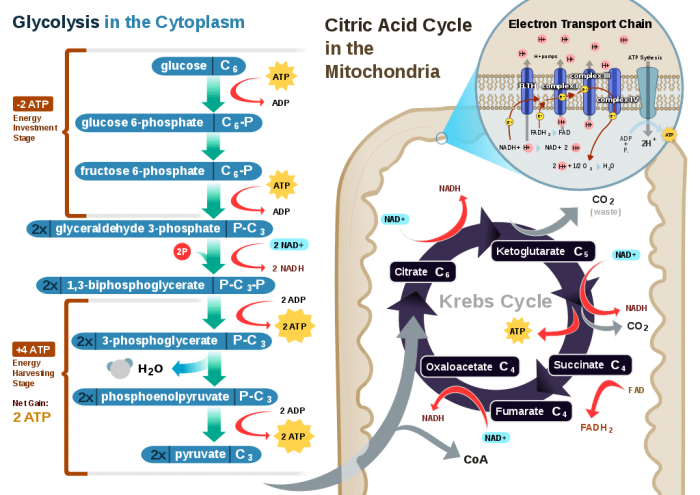
Cellular respiration formula is the collective term for a number of different processes which convert biochemical energy derived from nutrients into a molecule called adenosine triphosphate (ATP), the form of usable chemical energy needed to drive cellular processes.
This process takes in six molecules of oxygen and it produces water and carbon dioxide in addition to adenosine triphosphate or ATP. This process can be represented by the following chemical formula:
C6H12O6 + 6O2 –> 6CO2 + 6H2O + 36 or 38 ATP
The Products Of Cellular Respiration
You could also read the cellular respiration formula like this:
Glucose + oxygen –> water + carbon dioxide + energy
Basically, the cells in the human body and the cells of other heterotrophic organisms utilize glucose and oxygen to produce energy, with carbon dioxide and water being produced as a byproduct of this reaction. When you breathe in, you pull in oxygen and your body uses this oxygen along with the glucose you ingest to create the energy necessary to drive your cell’s activities.
The oxygen that is taken in by the lungs is used to degrade or break down the sugars pulled from the food you eat. This interaction between oxygen and sugar releases heat energy, in a fashion similar to how burning a log of wood releases energy. During the course of cellular respiration, after sugar’s energy is released and oxygen has broken down that sugar, carbon dioxide is produced as a byproduct. The energy derived from the sugars will be stored in the cells of the body for later use.
What has been described is the process of aerobic respiration, the term aerobic coming from the fact that it uses oxygen as a catalyst to derive energy. There is also anaerobic respiration, respiration done without oxygen. (However, anaerobic respiration is much less efficient at producing energy than aerobic respiration, creating much less ATP than aerobic respiration.) The process of aerobic respiration is typically divided into four separate processes. A portion of ATP that cells need is a direct result of the reactions that transform glucose. Yet most of the ATP produced by cellular respiration comes from the process/phase known as oxidative phosphorylation, which can also be thought of as the final step in the process.
The Phases Of Cellular Respiration
The four different phases of the cellular respiration process are: glycolysis, pyruvate oxidation, the citric acid cycle or Krebs cycle, and oxidative phosphorylation.

Phases of cellular respiration detailed: Glycolysis, citric acid/Krebs cycle, electron transport chain. Photo: By RegisFrey – Own work, CC BY-SA 3.0, https://commons.wikimedia.org/w/index.php?curid=4389845
Glycolysis is the first step of the cellular respiration process, and during glycolysis molecules of glucose are converted into other molecules through various chemical processes and transformations. Glycolysis essentially sets up the other three stages of the process to create ATP, producing a little ATP itself during this step. Glycolysis happens in the cytosol or cytoplasm of cells, and it can be done with oxygen or without oxygen. During aerobic respiration, glucose (a sugar molecule with six carbons) is transformed into two molecules of the substance pyruvate. The oxidation of pyruvate leads to the production of two molecules of NADH. These NADH molecules are responsible for the transportation of electrons to other reactions. Two molecules of ATP are also produced during this phase.
The next phase of the cellular respiration process is pyruvate oxidation. Pyruvate oxidation occurs after the pyruvate molecules produced during Glycolysis enter the mitochondrial matrix, which is the innermost portion of the mitochondria – the organelle responsible for the creation of energy. After pyruvate has entered the mitochondrial matrix it is fused with coenzyme A, and this fusion creates a new molecule referred to as acetyl CoA. Acetyl CoA is a two-carbon molecule, unlike pyruvate. The process of transforming pyruvate into acetyl CoA also generates more molecules of NADH and creates carbon dioxide as a byproduct.
The third phase in the cellular respiration process is the citric acid cycle, which goes by other names such as the Krebs cycle or the tricarboxylic acid cycle. During this phase, the acetyl CoA produced during the pyruvate oxidation phase undergoes a transformation, being fused with a molecule of oxaloacetic acid. This fusion creates citric acid, and of the citric acid will then undergo many different complex reactions. This stage is referred to as the citric acid cycle because the final step of this process creates more oxaloacetic acid, which sets up the cycle so it can start over. Carbon dioxide is released during the citric acid cycle, and ATP is produced. Along with ATP, molecules of FADH2 and NADH are produced.
The final phase of the citric acid cycle is oxidative phosphorylation. The molecules of NADH and FADH2, which were produced during the previous steps of the cycle, now drop the electrons they are carrying with them. The electrons are released into the electron transport chain. As a result of no longer being burdened with electrons, NADH and FADH2 are distilled down to NAD+ and FAD, their simpler forms. The electrons these molecules released now move through the electron transport chain, and this process is what releases energy.
As a result of the movement of electrons through the transport chain, protons are forced out of the mitochondrial matrix. When the protons leave the mitochondrial matrix they form a gradient. When the protons end up returning to the matrix, thanks to an enzyme referred to as ATP synthase, ATP is produced. The electron transport chain comes to an end when molecules of oxygen bond with protons after accepting electrons, which creates water.

Chemical structure of ATP. Photo: By Smokefoot – Own work, CC BY-SA 4.0, https://commons.wikimedia.org/w/index.php?curid=62118559
After the process is over, somewhere between 32 to 34 units of ATP will have been produced. Most ATP is generated when the proton gradient is created in the mitochondrial matrix. Oxidative phosphorylation generates somewhere between 26 to 28 units of ATP this way. Substrate phosphorylation also generates another 4 to 6 units of ATP. However, the actual yield of the process is around 30 ATP units because the setup for glycolysis uses a bit of ATP.
Cellular Respiration And Photosynthesis
Photosynthesis is what plants use to create energy for themselves. To do this, plants use pigments in their cells which trap certain wavelengths of light and the light energy is then converted into carbohydrates by organelles in the cells of the plant. Cellular respiration, meanwhile, converts glucose into ATP, using oxygen.
The process of cellular respiration and the process of photosynthesis have a special relationship with one another. The two processes are the opposite of one another, taking in the respective outputs of the other process for processing. This can be seen when comparing the equations for photosynthesis and cellular respiration side by side:
Here’s the equation for cellular respiration:
C6H12O6 + 6O2 –> 6CO2 + 6H2O + 36 or 38 ATP
Here is the equation for photosynthesis:
6H2O + 6CO2 → C6H12O6 + 6O2
The equation for photosynthesis is the inverse of the equation for cellular respiration. Plants utilize water and carbon dioxide to convert the energy from the sun into energy they can use, and they give off oxygen and glucose as a result of this process. In contrast, animal cells combine oxygen and hydrogen to create energy and release carbon dioxide and water as a byproduct. This relationship between animals and plants is referred to as the carbon cycle, referencing how carbon cycles through the entire biosphere, moving from animals to plants to the atmosphere and back through again.
Anaerobic Respiration
The type of cellular respiration previously talked about is called aerobic respiration, as it takes place in the presence of oxygen. However, when there is not enough oxygen for aerobic respiration to take place, certain cells can still generate energy through the execution of anaerobic respiration. Anaerobic respiration can make ATP without the oxygen that is usually required. However, it is much less efficient than aerobic respiration when it comes to how much ATP is produced, making about an eighteenth (1/18th) the amount of ATP that aerobic respiration produces.
One type of anaerobic respiration is fermentation. Fermentation is different from other methods of producing energy because unlike aerobic respiration where there are multiple steps that create ATP, in fermentation the glycolysis pathway is the only thing that extracts ATP. While glycolysis creates pyruvate in fermentation, the pyruvate does not proceed through the rest of the pathway, skipping the other phases associated with aerobic respiration, such as the citric acid cycle and the electron transport chain.
Since the electron transport chain is skipped during the fermentation process, NADH maintains its electrons. In order to compensate for the absent oxidation, Krebs cycle, and electron transport chain phases, there are a few reactions in fermentation capable of creating NAD+ out of NADH. This is accomplished by letting molecules of NADH acquire a molecule like pyruvate and steal the electrons from it. Doing this ensures that NAD+ can be created, and that the glycolysis process can start over again.










